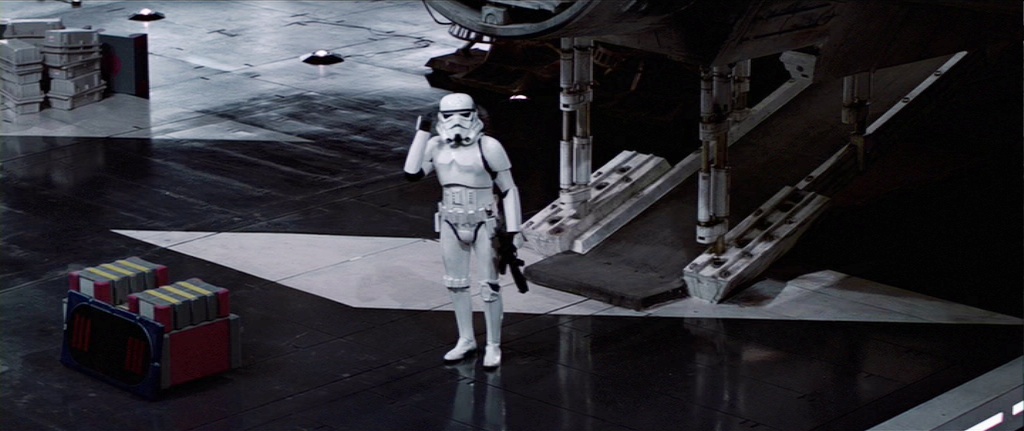"Always in motion is the future"
-Yoda
-Yoda
When life knocks you down and kicks you in the ribs, we tend to flee into our own sanctuaries to cope. Alternately, we tend to escape into our sanctuaries when we're happy too. They just give us a great way to relax and enjoy the good times.
Star Wars has done all of those things for me. It was there long before Dungeons and Dragons, and has greatly influenced my life and creative outlooks and inspirations. I got into Star Wars when I was about 8 (this age seems correct in my memory, as I know that Episode I came out when I was 9). My first Star Wars action figure was a Han Solo that came with a carbonite slab to freeze him in. I was a Jawa for Halloween when I was 9, and I was young Obi-Wan Kenobi when I was 10. My Lego building adventures always ended with some sort of epic lightsaber battle, and I always wanted to know about all of the aliens in Jabba's Palace. I also played the Decipher Star Wars card games.
I was excited for the prequels to come out, but I don't think I got into the first two as much as I got into Revenge of the Sith. For some reason, that story was just the culmination of everything I loved about Star Wars. I was in early high school, running track and enjoying a great season with friends and setting some awesome personal records, running 2 miles in under 10 minutes. I saw Revenge of the Sith twice in theaters, and had memorized all the dialogue (I had been doing that since I was little. Don't ask me how).

Anyway, so now that everybody can understand how prominent Star Wars has been in my life, let's look at some of the ways it has inspired me creatively and how to apply those lessons to D&D.
1. "If there's a bright center to the universe, you're on the planet that its the farthest from."
In Star Wars, every planet is a different fantastic location. Desert, forest, volcano, etc. Use these in your own D&D games when you try to figure out the theme of a location. Are the heroes going to explore a jungle? Are they climbing mountains? In essence, pick a terrain theme and think about what can be done to make it an amazing experience. In my Vellyn posts, I've taken the concept of snow to the next level, with avalanches, blizzards, and evil snow beasts. You should do the same.

2."You will never find a more wretched hive of scum and villainy."
D&D games should be full of interesting characters, not just the PC's. Populate your worlds with denizens exhibiting interesting clothing, personalities, or appearances. NPC's make the world, from that hammerheaded looking alien to the pale skinned woman watching a podrace. Your players will want to find out more about them, which may lead into some interesting adventures all on their own.


3. "I have a bad feeling about this."
Every adventure should have some threat to it. That's the whole point of Dungeons and Dragons. Great rewards require great sacrifice. Whether this comes from infiltrating an enemy outpost to rescuing a captive friend, your players should always feel the danger of what they are about to undertake.




D&D games should be full of interesting characters, not just the PC's. Populate your worlds with denizens exhibiting interesting clothing, personalities, or appearances. NPC's make the world, from that hammerheaded looking alien to the pale skinned woman watching a podrace. Your players will want to find out more about them, which may lead into some interesting adventures all on their own.


3. "I have a bad feeling about this."
Every adventure should have some threat to it. That's the whole point of Dungeons and Dragons. Great rewards require great sacrifice. Whether this comes from infiltrating an enemy outpost to rescuing a captive friend, your players should always feel the danger of what they are about to undertake.


4. "He was deceived by a lie. We all were."
In order to create complex, awesome villains, hiding them in plain sight always works well. Nothing is more shocking that finding out the person you trusted has fallen, or was always plotting against you from the start. Whether it was a character's father, or a well loved mentor, the shock of learning their true nature is enough to make any hero question their own motives and their possible destiny.


5. "You and the Naboo form a symbiont circle. What happens to one of your will affect the other. You must understand this."
Choices have consequences. For every action, there is an equal and opposite reaction. The same happens in D&D games. In order to fully take advantage of this, players need to be presented with choices. Do they stop the orcs from kidnapping the baron or let the trolls destroy the homesteads? While the heroes are saving the day in one area, what is happening in the other? Or, in a different sort of approach, what happens when one group allies with another, as opposed to the third party? As the DM, it's up to you to make that call.

I'm going to stop this post with those important lessons. I've used them in many of the games that I've run, and I think they add a solid depth to any game.
We'll see where life continues to take me. I'm trying to be strong, faithful, and courageous.
Be sure to leave your comments below, and follow me on Twitter @artificeralf
Comments
Post a Comment